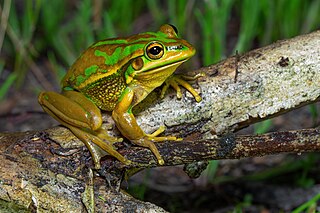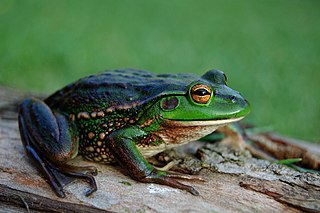
Litoria is a genus of hylid tree frogs native to Australia, the Bismarck Archipelago, the Solomon Islands, New Guinea, the Lesser Sunda Islands, and the Moluccan Islands. It is the only genus in the monotypic subfamily Litoriinae and are sometimes collectively referred to as Australasian treefrogs. They are distinguishable from other tree frogs by the presence of horizontal irises, no pigmentation of the eyelids, and their distribution east and south from Wallacea. Over 90 species are described, but several new species are described every year on average, such as the Pinocchio frog, discovered in 2008 and described in 2019.

The green and golden bell frog, also named the green bell frog, green and golden swamp frog and green frog, is a ground-dwelling tree frog native to eastern Australia. Despite its classification and climbing abilities, it does not live in trees and spends almost all of its time close to ground level. It can reach up to 11 cm (4.5 in) in length, making it one of Australia's largest frogs.

The eastern dwarf tree frog, also known as the eastern sedge-frog, is a small and very common tree frog found on the eastern coast of Australia, from around Cairns, Queensland, to around Ulladulla, New South Wales. Individual frogs of this species are often found elsewhere, having been accidentally relocated by transported fruit boxes. Confirmed sightings of breeding pairs have confirmed their survival in Victoria's cooler climate.

The Australian green tree frog, also known as simply green tree frog in Australia, White's tree frog, or dumpy tree frog, is a species of tree frog native to Australia and New Guinea, with introduced populations in the United States and New Zealand, though the latter is believed to have died out. It is morphologically similar to some other members of its genus, particularly the magnificent tree frog (R. splendida) and the white-lipped tree frog (R. infrafrenata).
Green tree frog is a common name for several different tree frog species:

The white-lipped tree frog is found in Australia and is the world's largest tree frog. Other common names include the New Guinea treefrog, giant tree frog, and Australian giant treefrog.

Tyler's tree frog or the southern laughing tree frog is an arboreal tree frog. It is native to eastern Australia. It occurs from southeast Queensland to the south coast of New South Wales. It is generally a coastal species and is not found inland.

The growling grass frog, also commonly known as the southern bell frog, warty swamp frog and erroneously as the green frog, is a species of ground-dwelling tree frog native to southeastern Australia, ranging from southern South Australia along the Murray River though Victoria to New South Wales, with populations through Tasmania. This species' common names vary between states; the name southern bell frog applies to New South Wales, growling grass frog in Victoria and South Australia, and green and gold frog in Tasmania. This species has been introduced to New Zealand.

The Jervis Bay tree frog, also known as the curry frog in reference to its odour, is a species of Australian frog associated with wallum swampland along the east coast of New South Wales; ranging from the Queensland border to eastern Victoria.

The striped rocket frog, or in its native range known as the rocket frog, occurs mostly in coastal areas from northern Western Australia to around Gosford in New South Wales at its southernmost point, with a disjunct population occurring further south at the Sydney suburb of Avalon. It also inhabits the southern lowlands and south east peninsula of Papua New Guinea.

Amphibians of Australia are limited to members of the order Anura, commonly known as frogs. All Australian frogs are in the suborder Neobatrachia, also known as the modern frogs, which make up the largest proportion of extant frog species. About 230 of the 5,280 species of frog are native to Australia with 93% of them endemic. Compared with other continents, species diversity is low, and may be related to the climate of most of the Australian continent. There are two known invasive amphibians, the cane toad and the smooth newt.

Roth's tree frog or the northern laughing tree frog is a tree frog native to northern Australia and southern Papua New Guinea. Roth's tree frog is a common frog, closely related to Peron's tree frog and Tyler's tree frog.

The desert tree frog or little red tree frog is a tree frog native to Australia, southern New Guinea, and Timor. It is one of Australia's most widely distributed frogs, inhabiting northern Australia, including desert regions and much of temperate eastern Australia. It is one of the few Australian tree frogs to inhabit arid, tropical, and temperate climates.
Beck's tree frog is a species of frogs in the subfamily Pelodryadinae. It is endemic to Papua New Guinea. Its natural habitats are tropical moist montane forests, grasslands and streams. It was first described by the British biologist and herpetologist Arthur Loveridge in 1945 and is named in honour of the American ornithologist and explorer Rollo Beck who led the Whitney South Seas Expedition in the 1920s, collecting bird and other specimens from thousands of islands in the South Pacific.
Litoriacastanea, also known as the yellow-spotted tree frog, New England swamp frog, tablelands bell frog, or yellow-spotted bell frog is a species of frog in the subfamily Pelodryadinae. It is a critically endangered species of frog that is endemic to southeastern Australia, found in the New England Tablelands bioregion. Its natural habitats are temperate grassland, rivers, intermittent rivers, swamps, freshwater lakes, intermittent freshwater lakes, freshwater marshes, intermittent freshwater marshes, and ponds.
The Cooloola sedge frog or Cooloola tree frog is a species of frog in the subfamily Pelodryadinae. It is endemic to Australia. Its natural habitats are swamps, freshwater lakes, intermittent freshwater lakes, freshwater marshes, intermittent freshwater marshes, and coastal freshwater lagoons. It is threatened by habitat loss. Cooloola Tree Frogs only live in Australia and their lack of distribution adds to their endangerment. They mostly feed on bugs in their area; flies, spiders, moths, etc. Their green skin helps camouflage them because of their very green and wet habitat.

The green-eyed treefrog is a species of Australasian treefrog in the subfamily Pelodryadinae that occurs in the Wet Tropics of Australia.
The parachuting frog or pale-eyed parachuting tree frog is a frog from the island of New Guinea. It is in the Nyctimystes gramineus complex with the Pinocchio frog and montane Pinocchio frog.
The montane Pinocchio frog is a frog from the island of New Guinea. Scientists saw it on Hides Ridge in the karstic area of the Southern Fold Mountains in Papua New Guinea. Like the Pinocchio frog, it has a protuberance on its snout that can grow or shrink.
Mareku's tree frog is a frog in the family Hylidae. It is endemic to Indonesia. Scientists have seen it in the Wondiwoi Mountains in Papua Province.













